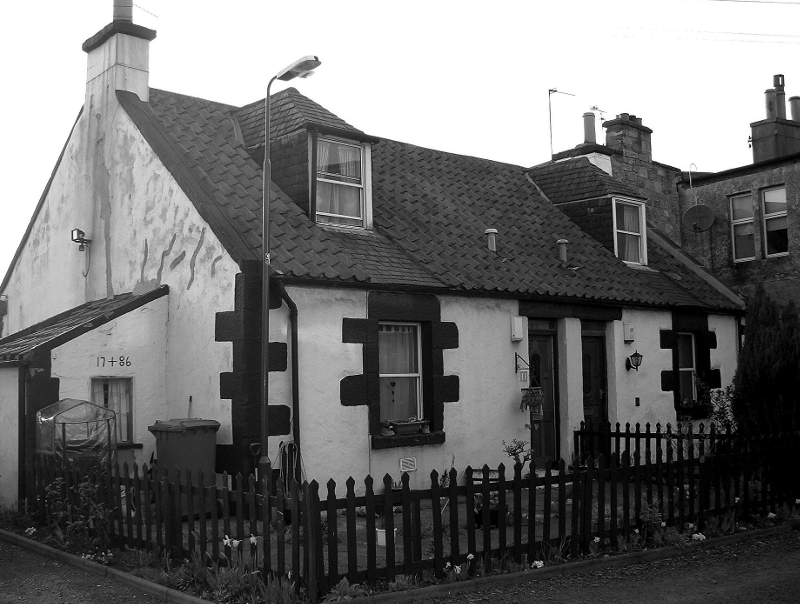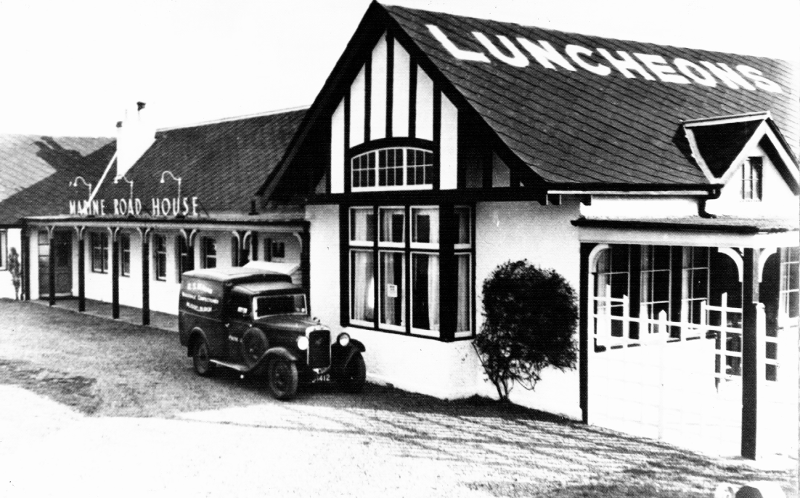Until early in the 19th century, the two fishing villages of Cockenzie and Port Seton were separate entities. The two communities gradually merged and, by 2000, were regarded much as one unit.
Latterly, a footpath linked the two harbours, and environmental improvements were underway. The coastline is attractive to people and birds alike. To the east, at Port Seton, is the beginning of the Site of Special Scientific Interest (SSSI) that runs from here to Aberlady.
Townscapes, Buildings & Landscapes of Distinction
Within the burgh are many older buildings of note, some of which have undergone several changes of use:
Barrack House, Links Road, Port Seton (northwest of Robertson’s garage) is a very old building, especially the west gable. It was there during Napoleonic times as a garrison building, although probably much earlier. The stone for the flagpole for the barracks can be seen at Bay View, which lies to the west of the property.
Cockenzie Fisherman’s Co-op and Store, New Street, Cockenzie was the first house built in New Street, c1865.
Cockenzie House was built in 1675 by the Seton family for their coal and salt masters. The building was added to on the north side of the house by the Cadell family who later resided there for nearly 200 years. The Hanseatic barn, which is located to the west of the house, was built before the house, and when the house was built it was attached to the barn. The barn was used for storing goods for export and imported goods. The barn was burnt out in 1980 but was restored in the 1990s. The house and barn were converted to form Cockenzie Nursing Home.
Gardners’ Close Cottage, High Street, Cockenzie (opposite the Thorntree Inn) was possibly built by the Gardners’ Society c1790.

Gardeners Close Cottages (off High Street, Cockenzie). The date 1786 is painted above the window on the left.
The Old Salt Stone Buildings, Marshall Street, Cockenzie was built by the Seton family and later by the Cadell family. Their saltpans were located in the same area.
Parkestone House, Edinburgh Road – now known as Crystal Sea – was built by Adam Donaldson, a Cockenzie boatbuilder, who had sold up and emigrated to Bluff, South Island, New Zealand c1880. On a trip home c1901, he built Parkestone House, and then returned to New Zealand.
Port Seton House, High Street (opposite Elcho Place) was built in 1709 as a summer house, and was one of the last houses built by the Seton family. The Hare family have been in residence for over 100 years.
In existence in 1788, Rose Cottage, Port Seton (corner of Links Road and Seton Place) was in later times used as a doctor’s surgery. By the end of the period, the owners, the Di Ciacca family, had altered the building externally and internally.
Set within the grounds of Seton House, Seton Collegiate Church site was originally occupied by a parish church. Catherine Sinclair, widow of William, the first Lord Seton (died 1409), added a south aisle and dedicated the church in the names of St Mary and the Holy Cross. The church was created a Collegiate in 1493 and was added to by the Setons over the years. In 1544 the church was desecrated by the English, later rebuilt and defaced again in 1715. The Setons lost their estates for participating in the 1715 uprising. The estates now belong to the Earl of Wemyss, and the church is used as a family mausoleum.
Seton Field House, Manse Lane was built by the Kelly family in the early 1800s, who were business people who came from Aberlady.
Seton House is a castle-type house built by Robert Adam 1789-91, using stone from the Old Palace of Seton, which stood on the site. The house was built for Alexander MacKenzie, the agent for the York Building Company. When the company was wound up, the Earl of Wemyss bought the house and estates. The house was leased to a Captain Stevenson and his family from 1947 to date. Both the church and house are situated one mile to the south of Port Seton with access from the A198 road.
Built in the 1920s, The Marine Road Housel, Links Road was formerly a tearoom, a clubhouse for the Port Seton Golf Club and latterly the Old Ship Inn hotel.

Marine Road House, Links Road, Port Seton, now The Old Ship Inn Hotel
The Thorntree Inn, High Street, Cockenzie is one of the oldest inns in East Lothian. In 1788 it was owned by McKenzie WS and a Mr Thomson, and was formerly known as Barclays Hotel. The Inglis family have owned the Thorntree for about 100 years.
Winton Lodge House, Winton Court was built in 1869 for the Hunter family who were bookbinders in Edinburgh. By 2000, the property was used as a senior citizen’s sheltered housing complex.
One building of note that was demolished in 1995 was the Pond and Pond Hall (opened 18 June 1932). Many local people had many fond memories of the hall. It had been the focus of the social life of the burgh for much of the period in question (see also Leisure and Economy – Tourism).
The Pond and the Pond Hall commissioned by the Burgh Council of Cockenzie and Port Seton was initiated and driven by Provost John Hall Weatherhead. He recognised the need to emulate Dunbar and North Berwick, and to develop the community as a seaside resort with its potential for business expansion, and also meet the present and future recreational requirements of Cockenzie and Port Seton.
The site chosen was the intersection of Fishersgate Road and the line of High Street. The project cost of £10,000 was financed and built with £625 from the burgh council, personal and community donations of monies and materials and voluntary labour over a period of two and a half years.
On opening in 1932, the pond had an Olympic standard pool, 50 yards x 25 yards with changing cubicles at east and west ends, and 1500 spectator capacity on both north and south sides. The following year, the Pond Hall was completed incorporating additional changing facilities, council chambers, library, tearoom and main function hall able to accommodate 800 with a sprung ballroom floor, one of three in Britain.
The Pond also had installed a 33-foot diving stage, the highest in Scotland. This was an immense achievement by a small fishing village in depressed times – with a population of just 2526. This figure contrasts with the estimate of 5150 for 1997, two years after the Pond’s closure.
The Earl of Wemyss sold the land to the Provost, Magistrates and the Burgh Council and their successors, subject to the conditions of a Feu Charter protecting and defining the uses and maintenance of the Pond and Pond Hall changeable only by Minute of Waiver.
As the years passed, the amount of necessary maintenance and upgrading increased. In 1964 the Pond had oil-fired heating installed. This was in preference to piping and pumping the coolant water from Cockenzie Power Station. The filter shell developed a hole in 1968 and was replaced with three new filters. At about the same time a proposal was discussed with regard to control and cost sharing with Prestonpans. This was not taken any further.
The burgh council in 1973 recognised the need to modernise, upgrade and add new facilities. Plans were drawn up and a model made. These were not taken any further by East Lothian District Council who took over control and responsibility after local government reform in 1974. Strict budget controls by the council resulted in low investment and maintenance (although heated showers were installed in 1991). In 1973 a leak appeared in the diving pit, which in 1974 was causing the loss of 8,000 gallons per week. The repair costs were considered to be too prohibitive and the west end cubicles were demolished and used to fill in the diving pit. The 1970s and 1980s saw the disappearance of the floodlights, glass canopy diving stage chute and springboard. Cracks in the sea pipe also appeared and combined with filtration problems required the pond to be filled with fresh water from an outside hydrant from 1988 onwards.
At the same time in 1988 a Scottish Development Agency report presented a lifeline with various options to upgrade the Pond and Pond Hall into an indoor leisure facility. This was shelved when the community who chose a swimming pool option rejected the East Lothian District Council’s decision to choose an ice rink development, intimating that monies were only available from the European Development Fund for new projects.
With attendances declining, and costs running at £12 per swimmer, the district council did not consider this economically justifiable and the Pond and Pond Hall did not open in 1994. That year also saw the opening of the Port Seton Leisure Centre in the King George V Park and also the decision to convert the Pond Hall site to a housing development.
1995 was to prove the final year; following 1994 when the community sent a 4,000 signature petition and 75 business letters of support, a meeting was held in September 1995 with the East Lothian District Council at which the community presented their business plan to retain and develop the Pond and Pond Hall for leisure and recreation. The community prior to this had received a letter of support for success from Nigel Tranter, the world-renowned Scottish author residing at Aberlady Bay.
The proposal was rejected by the council. Whilst sympathetic to the community’s wishes to retain this most important part of their heritage, it considered it to be too ambitious and costly (£1.4million), and also unnecessary in light of other sports developments in the vicinity.
Finally, in November 1995, Lord Osborne, presiding at the Court of Session, ruled that the district council could do as they wished, Lord Neidpath having prior to this having granted a Minute of Waiver to the Feu Charter to allow the site to be developed as a housing estate.
In December 1995, the Pond and Pond Hall were demolished and the Dr Black clock was transported to Hart Estates, Macmerry for safekeeping (see also Leisure and Economy – Tourism).